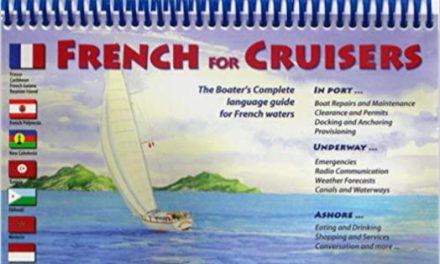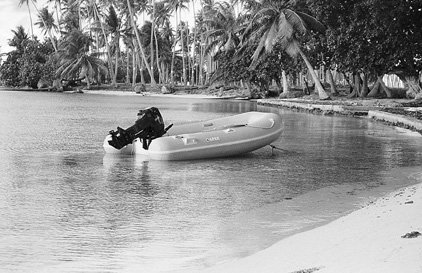A small, handsome double-ender with offshore potential
Issue 149: March/April 2023
 The 1970s was a transitional period in sailboat design, as CCA (Cruising Club of America) rules that had guided design for the previous 30 years were giving way to the new IOR (International Offshore Rule) ratings. Narrow beams, full keels, graceful sheer lines, and heavy displacement hulls were evolving to more modern designs that featured wider beams, fin keels, and lighter displacements. However, there were still designers and builders who produced traditionally styled salty-looking sailboats such as the Thomas C. Gilmer-designed Southern Cross 28 (SC28) cutter.
The 1970s was a transitional period in sailboat design, as CCA (Cruising Club of America) rules that had guided design for the previous 30 years were giving way to the new IOR (International Offshore Rule) ratings. Narrow beams, full keels, graceful sheer lines, and heavy displacement hulls were evolving to more modern designs that featured wider beams, fin keels, and lighter displacements. However, there were still designers and builders who produced traditionally styled salty-looking sailboats such as the Thomas C. Gilmer-designed Southern Cross 28 (SC28) cutter.
Perhaps it’s those salty lines that attract many owners to a Southern Cross, and Terry Ryan was no exception when she rescued her father’s neglected SC28 from the back corner of a boatyard in Oriental, North Carolina. Terry’s family is from Georgia, where she got her first taste of boating as a teenager helping her dad build Dolphin Senior sailboats in the garage and learning to sail them on Lake Lanier.
In the late 1980s, her parents, Allen and Margarete, were looking to broaden their sailing horizons and bought a 1978 Southern Cross 28 (Hull #5) in West Palm Beach, Florida. Renaming the boat Alamar, they sailed it to Oriental and enjoyed local sailing in the Neuse River for several years before moving back to Georgia and leaving Alamar in the marina.
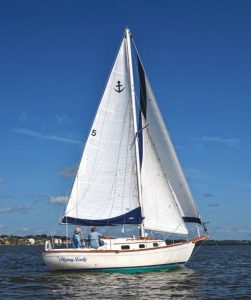
With the round transom, spoon bow, bowsprit, and cutter rig, the Southern Cross 28 looks ready for serious voyaging.
After surviving several hurricanes, the boat was put on the hard in the boatyard, where it remained until Terry had it trucked back to Florida in 2011 for a refit. Terry renamed the boat The Flying Lady, a nod to her 32 years as a commercial pilot flying 737s. Terry and her wife, Lauriann’s, long-term goal is to bring this little cutter back to Bristol condition, and although they have no plans to cross oceans, The Flying Lady will certainly catch attention while daysailing on the Indian River Lagoon (IRL).
History and Design
Gilmer attended the U.S. Naval Academy, graduating in 1935, then served in the Navy for several years before returning to the academy as an instructor in naval engineering. In 1962, he designed the 30-foot Allied Seawind ketch, the fi rst fi berglass yacht to circumnavigate the globe. After his retirement in 1967, Gilmer founded his own naval architecture fi rm in Annapolis, Maryland. He went on to design 17 sailboats along with working on historic reproductions of classic sailing ships such as the Pride of Baltimore, a 90-foot topsail schooner.
Southern Cross sailboats were built in Bristol, Rhode Island, by the C.E. Ryder Corporation, founded by Clarke Ryder in 1969. The company initially started off as a manufacturer of fi berglass industrial parts, but in the early 1970s Ryder saw how popular the Westsail 32 was in its kit form; he contacted Gilmer to design the Southern Cross 31, which was launched in 1975 and was also available as a bare hull. The boatyard closed in 1990 after building more than 280 Southern Cross yachts.
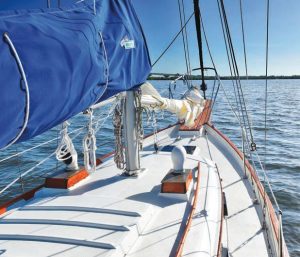
The deck plan is clean, with few obstacles or
tripping hazards.
In addition to Southern Cross boats, Ryder also built boats for Sea Sprite and Eastward Ho. Ryder offered the Southern Cross product line as fully completed boats and also at several levels of completion for the do-it-yourself sailor.
The SC28, fi rst built in 1978, is a classic-looking cutter with a long bowsprit, pleasing lines, and a double-ended stern. In the 1980s, the SC28 kit boats were designated as the Gilmer 28 to distinguish them from factory-fi nished models. There were 66 SC28s built, along with six Gilmer 28s, although many kits were sold before the name change. The factory-finished boats usually had a bronze builder’s medallion in the cockpit.
For its size, the SC28 proved to be a capable bluewater vessel that could cross oceans if properly prepared. In 2005, Donna Lange circumnavigated on a SC28 that had gone through an extensive refi t but even so, had serious hull-to-deck joint issues.
Construction

The sculpted cockpit provides high backrests and good stowage in the three lockers.
C.E. Ryder produced what many owners consider a heavily built boat that has few blister problems. The hull is composed of a 1-inch fi berglass laminate sandwich with an Airtex foam core, while the deck is cored with balsa wood. Foam core has an advantage over balsa wood as it is less water permeable. But it comes with higher construction costs.
The hull-to-deck joint is an outward-turned fl ange design that is fastened with ¼-inch stainless steel bolts on 8-inch centers with the deck side of the joint forming a 4-inch-high bulwark. A teak cap rail covers the fl ange. The joint is sealed with a rubber gasket, but over time and cyclic loading the gasket may harden and lose its sealing capability, allowing leaks along the joint as reported by some owners, including Terry. Part of The Flying Lady’s refi t included caulking the joint and rebedding stanchions, chainplates, and other deck hardware.
While the SC28 has been described as having a fi n keel with a separate rudder, looking at the underbody line drawings, with its long cutaway keel, it’s not hard to imagine this boat had its roots in a full-keel design. Several owners stated that the keel design makes the boat very maneuverable, with a tight turning radius, while also allowing it to track like a full-keel boat. Lead ballast is encapsulated inside the keel. The rudder skeg is molded as part of the hull and has a lower bearing for support, but the rudder extends below the skeg and is prone to catching lobster pot lines, according to an owner who sails the coast of Maine.
The pros and cons of a double-ended stern are still debated today, with many theories on why they are better than a flat stern (mostly in a following sea). But even Bob Perry, designer of the Valiant 40, which helped rejuvenate interest in doubleended sailboats, states that while the design may help balance the boat, it doesn’t necessarily make the boat more seaworthy by parting following seas (the so-called “Moses effect”); Perry says he just plain likes the look of them. Disadvantages of this type of design are generally less storage room in cockpit lockers, pinched cockpit seating at the helm, and fewer options for mounting cruising gear.
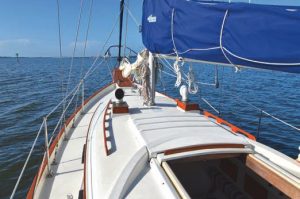
The companionway hatch is protected by a sea hood to keep out rain and boarding seas — an important offshore feature. Notice that one Dorade vent faces forward for air intake and the other aft for exhaust.
Rigging
The SC28 rig is configured as a masthead cutter with twin forestays and a single backstay. Terry replaced the original hanked-on Yankee with a Harken furler for ease of sail handling. The staysail is mounted on a boom, which gives additional control over the self-tending sail but becomes an obstacle when you’re moving around the foredeck and prevents a dinghy from being stored there.
Lateral rigging is a single upper stay with fore and aft lower stays at the spreaders. The shrouds lead to chainplates that are mounted just inside the bulwarks. The chainplates are throughbolted to fiberglass ribs that are glassed into the hull and are easily accessible from inside the cabin.
The aluminum mast fits into a stainless steel mast step that is bolted to a solid fiberglass section of the cabin top; this solid construction avoids the problem of leaks and core rot in the step area.
The SC28 doesn’t utilize an interior compression post to support the mast. Instead, it relies on the cabin bulkheads fore and aft of the mast, along with the reinforced cabin top, to provide structural strength. The bulkheads are bonded to the hull, with the joint glassed over with a layer of fiberglass cloth.
The mainsheet hardware is mounted at mid-boom and leads to a cockpit-mounted traveler. All three halyards along with the mainsail reef lines are controlled at the mast by a pair of Barlow 16 winches. The sheets for the headsails are trimmed with Barlow 20 winches mounted on the cockpit coamings. The headsail and mainsail sheets are all within easy reach of the helm, making the SC28 a good choice for those who singlehand.
On Deck
With its narrow beam, rounded stern, tiller steering, and mainsheet traveler, the SC28 cockpit can best be described as snug. This is not necessarily a bad feature, as a small cockpit with tall coaming helps to keep water out and the crew in when the seas are up. The coaming curves up along the cabin top to the aft end of the sea hood and helps protect the cockpit from water coming over the cabin top. There are three small lockers built into the benches and a hatch in the deck to access belowdeck equipment.
Going forward from the cockpit, the sidedecks are easy to traverse due to the full-length handrails on the cabin top and the bulwarks that help keep feet inboard when the boat heels over. The Flying Lady does not have lifeline gates or a boarding ladder, which is a safety concern, so a portable ladder has been added to the ship’s inventory. A Danforthstyle anchor is hung on bow pulpit brackets with the anchor rode passing through a deck pipe to a chain locker in the forepeak. Since starting her long-term refit, Terry has replaced the standing rigging, installed a Mack Pack sail cover for the mainsail, added the roller-furling headsail, and painted the hull, topsides, and interior with white Interlux Perfection.
Belowdecks
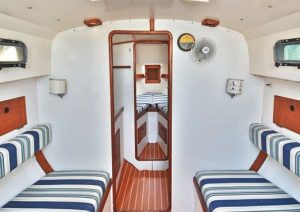
Looking forward from the main cabin. Bulkheads are white with varnished wood trim for the classic New England treatment.
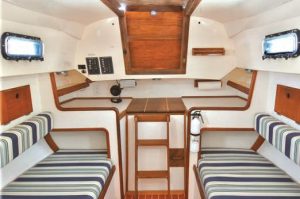
There’s not much galley counter space and getting close to it isn’t easy, given the companionway ladder, which is removable.
The main cabin has been described as large by one owner and cozy by another. Headroom is listed at just over 6 feet, which is true at the aft end of the cabin, but I found myself (5’10”) having to duck my head when going forward; the head and V-berth were a tight fit for me.
With factory and DIY options, along with design changes, there are probably few SC28s outfitted exactly the same down below. The Flying Lady was built with white laminated plywood for the bulkheads and cabinetry. The fiberglass overhead liner is also white, which, along with the light-colored bulkheads, helps brighten the interior but can make the cabin feel a bit monochromatic. Teak trim and cabinet doors along with a teak-and-holly laminated plywood cabin sole help add some contrast.
Hull #5 came equipped with a minimal galley, a pressure alcohol stove to port, a small sink with a manual water pump under the companionway opening, and a small icebox to starboard. Later models have a more user-friendly galley layout. During The Flying Lady’s engine refit, the galley cabinetry was removed and rebuilt, which gives better engine access, but Terry decided not to reinstall the sink and stovetop as she uses the boat primarily as a daysailer.
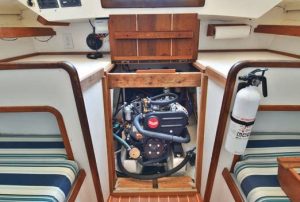
Engine access is from the front and above and makes servicing reasonably easy.
While the settees measure 6 feet long, most crewmembers will find their feet tucked into cubbyholes in the galley bulkhead when they stretch out for a nap. There is storage in cabinets above and below the settees but no hanging locker. Lighting in the saloon is provided by two old-school fixtures that give the cabin a vintage look. Going forward, the head occupies a narrow space between the main cabin and the V-berth, with a door to close off the saloon but not the forward cabin. The head is laid out with the marine toilet and a locker to starboard and a vanity with a sink and storage to port. The SC28 was built without a holding tank, so the head discharges directly overboard, which now violates federal and local laws. A small holding tank could be added, but Terry has decided to remove the old head and replace it with a portable toilet.
The forward cabin is compact, but a filler between the V-berth cushions adds some elbow room. A shelf runs along each side of the cabin with additional storage lockers beneath the berth. The forward cabin has a padded vinyl liner on the hull sides, which provides some insulation in cooler weather. Ventilation through the boat is provided by a large hatch over the V-berth, six opening ports, and two Dorade vents in the saloon, along with a DC fan for when the breeze dies. Bronze ports and deck hardware were an expensive option ($645) at the time, so Hull #5 was ordered with the standard plastic port lights.
Mechanical
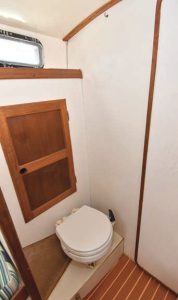
The toilet can be closed-off for privacy.
Several sources list the SC28 as having a Universal 11-hp diesel engine with a three-blade prop, but The Flying Lady came with a 12-hp Yanmar YSM12. One owner felt the SC28 was underpowered with the 11-hp engine when driving into a strong current or head sea. The original engine was replaced in 2021 with a Yanmar 2YM15, along with having a dripless prop shaft seal installed. The front of the engine is accessed by removing the companionway steps; however, the aft end of the engine is difficult to reach from the cockpit floor hatch. A 15-gallon fiberglass fuel tank is molded into the hull on the port side of the engine compartment and would be a challenge to repair or replace.
The SC28 was designed with a minimal electrical system that includes one small DC switch/ fuse panel to provide power to the nav and interior lights. Terry replaced this panel with one that has eight circuit breakers and also installed an AC shorepower circuit for a battery charger and outlets. A GPS chart plotter/depth finder and VHF radio round out the electronics. Two Group 24 batteries are adequate to power this setup.
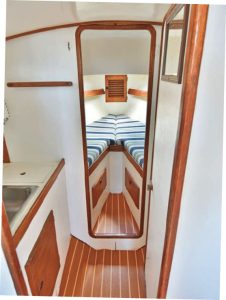
Looking aft from the forward cabin, the head sink is opposite the toilet, with an opening portlight for ventilation.
The fiberglass water tank holds 47 gallons, which is substantial for a boat of this size. The tank is molded into the hull below the cabin sole. An access port in the galley floor allows for inspection and cleaning. The Flying Lady had hand pumps in the galley and head, but a water filter and 12-volt pump were added later.
Underway
My first sail on The Flying Lady was on the IRL just west of Merritt Island, where Terry keeps the boat at Harbortown Marina. I noticed when I stepped aboard the boat that it heeled over more than I expected, owing mainly to its hull shape and narrow beam. The new Yanmar powered us at 6 knots through the Barge Canal to the IRL, where we raised the main and Yankee; the staysail was out for repair. The wind was blowing from the southeast at 10 to 15 knots with a fair chop. We had some rigging and hardware issues, so we only got a few tacks in before calling it a day. I’m used to sailing heavier, beamier boats, so my first impression was the SC28 was a bit tender as the boat wanted to put the rail in the water. I didn’t think it was a fair test, so we planned another sail later.
After some rerigging, Terry and I got out for a nice sail on the Banana River, with the launch towers of Kennedy Space Center off on the horizon. The wind was light and variable, around 10 knots with a few higher puffs thrown in. We raised all three sails and headed north with the wind on the starboard stern quarter. We cruised along at 5 knots on this point, and I suspect we might have gotten a bit more if we dropped the staysail, since it was blanketing the jib. The boat accelerated nicely when we got a gust and tracked well with little effort on the tiller. (An owner who sails on the West Coast says his boat sails easily over its calculated hull speed going downwind.)
When it was time to tack and head back upwind, rolling in the Yankee first made coming about much smoother, otherwise it would hang up on the staysail. We didn’t have a wind indicator at the masthead and my lack of experience with a cutter rig had me tweaking the sails trying to find the sweet spot. The gusts would heel the boat over to the rail as before, and I found myself working the mainsheet more like a sailing dinghy than a keel boat — which actually was fun. With variable winds and lack of the Windex, I couldn’t put a number on how well the SC28 points, but with proper trim it seemed to sail well closehauled. The sail trim on the cutter rig takes time to master, but I found the SC28 quick, responsive, and easy to handle.
Conclusion
The Southern Cross 28 is a salty-looking, traditional cutter with pleasing lines, and while it’s not a fast passagemaker, many owners feel that with its long keel, ample ballast, and conservative but versatile sail plan, the SC28 makes a good coastal cruiser. With its compact size, it is more suited to sailors who singlehand or couples who like to snuggle up in close quarters.
As with many older sailboats that had short production runs from builders now out of business, finding information for the SC28, as well as the boats themselves, can be challenging. A good place to start is the Southern Cross Owners Association. An internet search shows very few SC28s for sale, with a price range from $19,000 to almost $30,000 for an updated and well-equipped model. For an owner such as Terry, it is the love of the design and a desire to sail that make updating and maintaining the SC28 worthwhile.
Joe Cloidt is a retired electrical engineer who lives and sails on Florida’s east-central coast. When he isn’t out cruising on his Pearson 31 or racing on a J/30 at the local yacht club, he can often be found in his shop tinkering on his latest project or simply messing about in boats.
Thank you to Sailrite Enterprises, Inc., for providing free access to back issues of Good Old Boat through intellectual property rights. Sailrite.com



